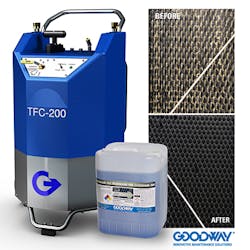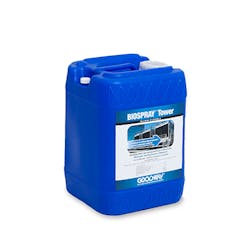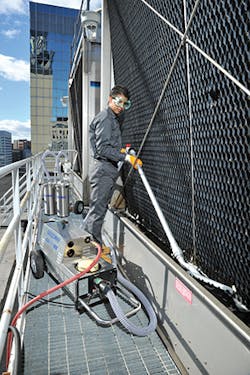Dirty cooling towers can be deadly. In July, an outbreak of Legionnaires’ disease in New York sickened 27 people and led to one death. Health officials traced the source of the Legionella bacteria to a cooling tower for a housing complex in Upper Manhattan. It’s an issue that can be a threat to any facility with cooling towers, including industrial operations.
In 2016, 23 people fell ill and one died after a Legionnaires’ outbreak at a juice plant in Minnesota. These recent outbreaks serve as a reminder that cooling tower cleaning and maintenance must be a priority and requires a comprehensive approach, says Ray Field, Director of Liquid Solutions at Goodway Technologies a global manufacturer and marketer of industrial maintenance and cleaning solutions.
“There’s a misconception that if the water is in good shape and you test it and have the correct biocides, you’re OK,” Field says.
But proper cooling tower maintenance requires much more than water treatment and testing, according to Field. NED recently spoke with Field to gain insight into these maintenance practices and how they can reduce risks related to Legionella bacteria.
NED: Why is cooling tower maintenance at the forefront again?
There have been recent Legionella outbreaks in New York City and all over the world that have sickened people. And it all goes back to proper hygienic measures with the cooling tower. You need to keep the tower’s structural members clean. There’s typically an emphasis on what the water looks like and how clean is it, and that’s good. Water-treatment providers will apply biocides, such as chlorine or bromine, but the water isn’t the only thing that requires attention. The tower’s external structures, such as the tower fill, can harbor bacteria. That’s a sensitive area where aerosolization (when water is converted into vapor) happens. So you want to keep tower fill clean and conduct periodic Legionella testing in the tower water. The tower also should have a bypass rack with mesh screen that should also be sampled to see what the microbial populations look like there. There are a lot of things that go into the mitigation of Legionella, and if they’re neglected you’re creating a Legionella breeding ground.
NED: Can you talk about some of the specific steps facility managers can take to keep cooling towers clean?
Years ago, you would have an operations worker spray down the cooling tower with a pressure washer. That’s not effective because the fill is plastic, and you don’t want to blow holes in it. Also, it’s difficult to remove tenacious mineral salts that may have taken hold in the fill. We recommend using the TFC-200, which is a device that atomizes and sprays a gel across tower fill surfaces. It’s an inhibited acid that dissolves calcium. This should be followed by a polishing step. The TFC-200 includes a turbo-tip nozzle and a wand that deploys the gel, which clings to the surface and dissolves most of the deposits. The rest of it can be cleared away by the wand with the turbo tip, which sprays water at 350 psi and gets rid of any extraneous debris.
We also suggest using BioSpray® Tower, which is a material called chlorine dioxide. You can spray this all over the tower’s structural membranes to prevent and mitigate Legionella from hanging on peripheral structures.
Another material we have that can be applied is TowerShine™. This is a strong detergent surfactant that can eliminate organic debris associated with biofilm in the tower itself. Also, in combination with the use of a Cooling Tower Vacuum, it can remove mud in the tower basin – or any other area that would provide for growth of Legionella.
NED: How frequently should facilities conduct Legionella testing, and what should they test?
If you have a slipstream of cooling tower water moving through a bypass rack like a mesh screen, you can send that into a lab to see if there’s an appreciable Legionella count. You also can send samples of the cooling tower water, as well. But bulk water doesn’t capture biofilm. Mesh screens capture biofilm and give a more accurate indication of Legionella.
You typically collect and analyze water microbiological samples two times per week by kits (Microbial Dip Slides) supplied by your water treatment company to see what total bacteria counts are in the tower bulk water. Mesh screens can be sent to a certified laboratory for Legionella testing every month-and-a-half or so.
NED: In addition to preventing Legionella, what are the other benefits of cooling tower maintenance?
If you have a tower filled with calcium salts and scale deposits and the fill isn’t operating with sufficient air flow, it’s not going to be efficient. Also, if you have a substandard water treatment program, scale can form inside the chiller tubes. This impacts the whole chiller and can lead to higher electricity costs. The lack of efficiency and associated costs due to neglect of the cooling tower can add up quickly.
About the Author
Goodway Technologies Corp.
Goodway Technologies is a global manufacturer and marketer of industrial maintenance and cleaning solutions for commercial HVAC, facility management, food and beverage, manufacturing, power generation, maritime and other industrial applications.
Incorporated in 1966, our innovative products have been used by facilities and plant maintenance personnel worldwide for the maintenance of HVAC systems, plant machinery, hazardous material cleanup and other industrial maintenance needs. We manufacture and ship from a 60,000 square foot plant in Stamford, CT, USA. Our products include tube cleaning systems, industrial vacuums, cooling tower maintenance systems, dry vapor sanitation solutions, descaling systems, coil cleaning products, hose & pipe cleaning systems and more.




